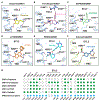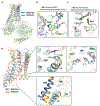Ligand recognition and allosteric regulation of DRD1-Gs signaling complexes
- PMID: 33571432
- PMCID: PMC11005940
- DOI: 10.1016/j.cell.2021.01.028
Ligand recognition and allosteric regulation of DRD1-Gs signaling complexes
Abstract
Dopamine receptors, including D1- and D2-like receptors, are important therapeutic targets in a variety of neurological syndromes, as well as cardiovascular and kidney diseases. Here, we present five cryoelectron microscopy (cryo-EM) structures of the dopamine D1 receptor (DRD1) coupled to Gs heterotrimer in complex with three catechol-based agonists, a non-catechol agonist, and a positive allosteric modulator for endogenous dopamine. These structures revealed that a polar interaction network is essential for catecholamine-like agonist recognition, whereas specific motifs in the extended binding pocket were responsible for discriminating D1- from D2-like receptors. Moreover, allosteric binding at a distinct inner surface pocket improved the activity of DRD1 by stabilizing endogenous dopamine interaction at the orthosteric site. DRD1-Gs interface revealed key features that serve as determinants for G protein coupling. Together, our study provides a structural understanding of the ligand recognition, allosteric regulation, and G protein coupling mechanisms of DRD1.
Keywords: DRD1-Gs complex; allosteric regulation; catecholamine; ccryo-EM; dopamine receptor; noncatechol; positive allosteric modulator; structure.
Copyright © 2021 Elsevier Inc. All rights reserved.
Conflict of interest statement
Declaration of interests The authors declare no competing interests.
Figures







Comment in
-
Novel Cryo-EM structures of the D1 dopamine receptor unlock its therapeutic potential.Signal Transduct Target Ther. 2021 May 22;6(1):205. doi: 10.1038/s41392-021-00630-3. Signal Transduct Target Ther. 2021. PMID: 34023856 Free PMC article. No abstract available.
Similar articles
-
Structural insights into the human D1 and D2 dopamine receptor signaling complexes.Cell. 2021 Feb 18;184(4):931-942.e18. doi: 10.1016/j.cell.2021.01.027. Epub 2021 Feb 10. Cell. 2021. PMID: 33571431 Free PMC article.
-
Ligand recognition and biased agonism of the D1 dopamine receptor.Nat Commun. 2022 Jun 8;13(1):3186. doi: 10.1038/s41467-022-30929-w. Nat Commun. 2022. PMID: 35676276 Free PMC article.
-
Structural basis of ligand recognition and self-activation of orphan GPR52.Nature. 2020 Mar;579(7797):152-157. doi: 10.1038/s41586-020-2019-0. Epub 2020 Feb 19. Nature. 2020. PMID: 32076264
-
The First Negative Allosteric Modulator for Dopamine D2 and D3 Receptors, SB269652 May Lead to a New Generation of Antipsychotic Drugs.Mol Pharmacol. 2017 Jun;91(6):586-594. doi: 10.1124/mol.116.107607. Epub 2017 Mar 6. Mol Pharmacol. 2017. PMID: 28265019 Free PMC article. Review.
-
Dopamine D2 Receptors Dimers: How can we Pharmacologically Target Them?Curr Neuropharmacol. 2018 Jan 30;16(2):222-230. doi: 10.2174/1570159X15666170518151127. Curr Neuropharmacol. 2018. PMID: 28521704 Free PMC article. Review.
Cited by
-
Quinpirole ameliorates nigral dopaminergic neuron damage in Parkinson's disease mouse model through activating GHS-R1a/D2R heterodimers.Acta Pharmacol Sin. 2023 Aug;44(8):1564-1575. doi: 10.1038/s41401-023-01063-0. Epub 2023 Mar 10. Acta Pharmacol Sin. 2023. PMID: 36899113 Free PMC article.
-
In Silico Prediction and Validation of CB2 Allosteric Binding Sites to Aid the Design of Allosteric Modulators.Molecules. 2022 Jan 11;27(2):453. doi: 10.3390/molecules27020453. Molecules. 2022. PMID: 35056767 Free PMC article.
-
Novel Cryo-EM structures of the D1 dopamine receptor unlock its therapeutic potential.Signal Transduct Target Ther. 2021 May 22;6(1):205. doi: 10.1038/s41392-021-00630-3. Signal Transduct Target Ther. 2021. PMID: 34023856 Free PMC article. No abstract available.
-
Structures of the human cholecystokinin 1 (CCK1) receptor bound to Gs and Gq mimetic proteins provide insight into mechanisms of G protein selectivity.PLoS Biol. 2021 Jun 4;19(6):e3001295. doi: 10.1371/journal.pbio.3001295. eCollection 2021 Jun. PLoS Biol. 2021. Update in: PLoS Biol. 2024 Jul 31;22(7):e3002673. doi: 10.1371/journal.pbio.3002673. PMID: 34086670 Free PMC article. Updated.
-
Systematic Analysis of Neurotransmitter Receptors in Human Breast Cancer Reveals a Strong Association With Outcome and Uncovers HTR6 as a Survival-Associated Gene Potentially Regulating the Immune Microenvironment.Front Immunol. 2022 Mar 10;13:756928. doi: 10.3389/fimmu.2022.756928. eCollection 2022. Front Immunol. 2022. PMID: 35359970 Free PMC article.
References
Publication types
MeSH terms
Substances
Grants and funding
LinkOut - more resources
Full Text Sources
Other Literature Sources

